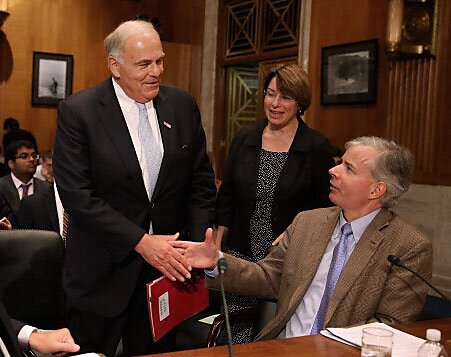I testified
to the congressional Joint Economic Committee today regarding the nation’s infrastructure challenges. Former Governor Ed Rendell also testified, and the hearing was chaired by Senator Amy Klobuchar.
The way ahead for infrastructure is to privatize as much of it as we can. Let’s give America’s entrepreneurs a crack at financing, owning, and managing our airports, seaports, and other facilities.
Infrastructure privatization has swept the world, but there are numerous hurdles to such reforms in this country. Here are some of the issues I raised to the committee:
- Tax exemption on municipal bond interest. When state and local governments borrow funds to build infrastructure, the interest on the debt is tax-free under the federal income tax. That allows governments to finance infrastructure at a lower cost than private businesses, which stacks the deck against the private provision of infrastructure. Policymakers should consider phasing-out the tax exemption on state and local bond interest, perhaps in exchange for reducing overall tax rates on capital income.
- Income and Property Taxation. Government facilities don’t pay income taxes. While state-owned airports are tax-exempt, for example, a for-profit airport would have its net earnings taxed at both the state and federal levels. Similarly, government-owned facilities are exempt from property taxes almost everywhere in the United States, while for-profit businesses often bear a heavy burden of property taxes on their land, structures, and machinery and equipment. Note that by privatizing infrastructure and thus subjecting it to taxation, governments would be broadening the tax base. They could use the added revenues from base broadening to reduce overall tax rates, which would spur greater investment of all types in the economy.
- Crowding Out. The existence of government infrastructure—which is often provided at artificially low prices to the public—deters potential private investments. Private highways, for example, face an uneven playing field because drivers on a private highway would have to pay the private tolls plus the gasoline taxes that fund the government’s “free” highways.
- Federal subsidies. The crowding out problem is exacerbated when federal subsidies tilt state and local decisionmakers in favor of government provision. Potential private airports, for example, are not eligible for most federal airport subsidies. Consider that before the 1960s, most urban bus and rail services in America were privately owned and operated. But that ended with the passage of the Urban Mass Transportation Act of 1964. The Act provided subsidies only to government-owned bus and rail systems, not private systems. That prompted state and local governments across the country to take over private systems, swiftly ending more than a century of private transit investment in America’s cities.
- Federal regulations. Federal regulations have restricted efforts to privatize state and local infrastructure. One issue has been that states receiving federal aid for their facilities have been required to repay the aid if the facilities are privatized. These rules have been liberalized over the years, but they may still create a disincentive to privatize in some cases. Another issue is that tolling has been generally prohibited on interstate highways, which prevented public-private partnership (P3) projects. However, the 2012 highway bill (MAP-21) allowed for the tolling of new capacity on the interstates, which is a step forward. Federal policymakers should work to eliminate remaining regulations that stand in the way of infrastructure privatization.
- Labor Unions. Privatization would undermine the power of the public-sector unions that often dominate government services, and so unions actively lobby against reforms. Unions lobby against contracting-out airport security screening operations. The National Air Traffic Controllers Association lobbies against ATC privatization. And in the District of Columbia, unions are trying to block a proposal to allow private operation of some bus services. One solution to the problem is to ban monopoly unions (“collective bargaining”) in the public sector, which is the rule in a number of states.
- Social Security. The structuring of Social Security as a pay-as-you-go system is a negative for privatized infrastructure. One of the fuels for the rise in P3s in other countries has been growing investment by pension funds. Infrastructure investment is a good fit for pension funds because it provides a return over a very long period of time, which matches the pattern of long-term liabilities of these funds. In Canada and Australia, the growth in P3s has been partly driven by the pools of savings created by reformed government retirement programs. In the United States, reforms to create Social Security private accounts would create a large pool of long-term savings to help fuel private infrastructure investment.
Federal policymakers should aim to reduce these hurdles for private investment. After all, private infrastructure is not a new or untried idea. Before the 1960s, urban transit services were mainly private. And before the 20th century, private turnpike companies in America built thousands of miles of toll roads.
The takeover of much infrastructure by governments in the 20th century was a mistake, and many policymakers here and abroad are now working to correct the overreach. The federal government should cut subsidies and reduce its control over the nation’s infrastructure. State and local governments should be encouraged to innovate with privatization to the fullest extent possible.
My full testimony is here.
Statements by the other panelists are here.

